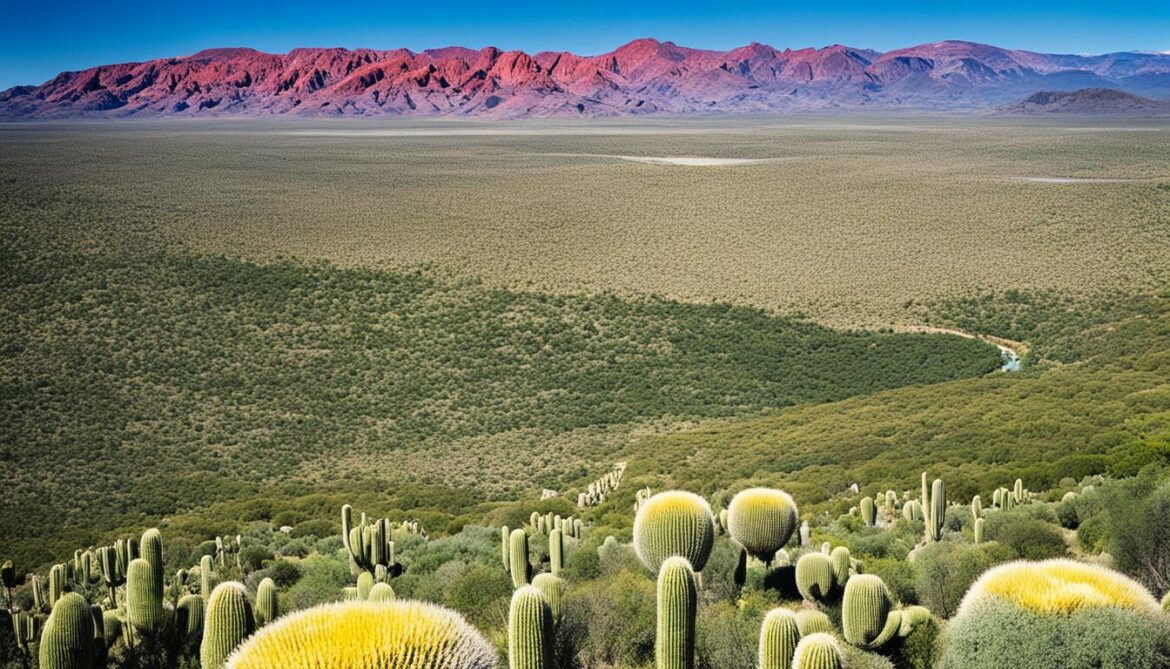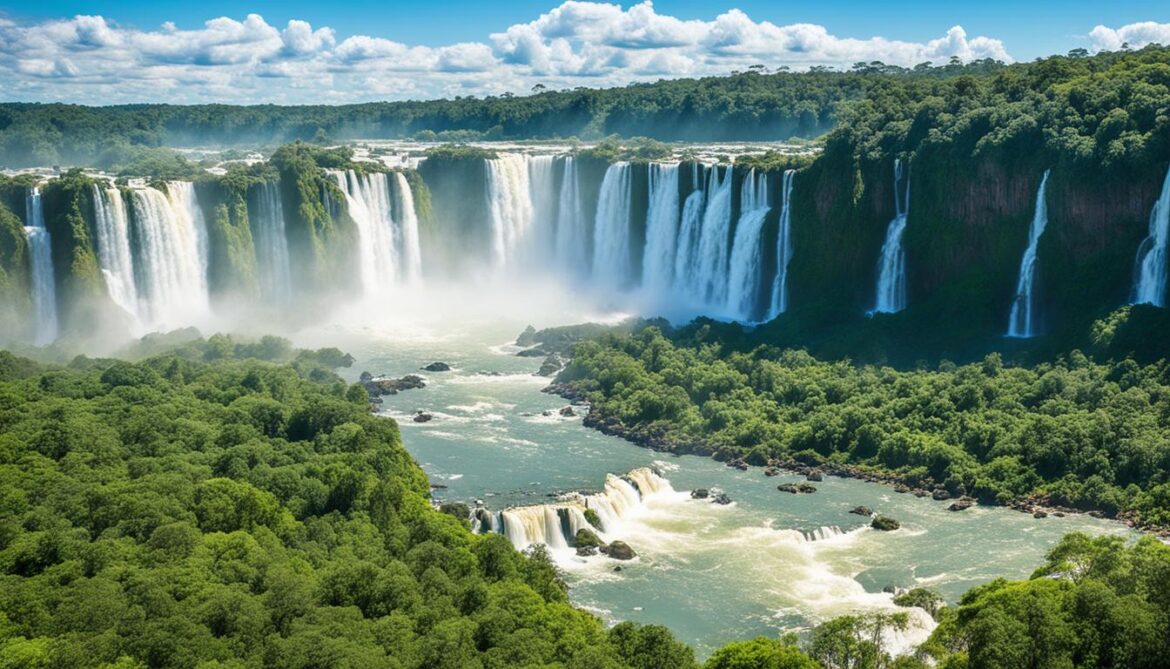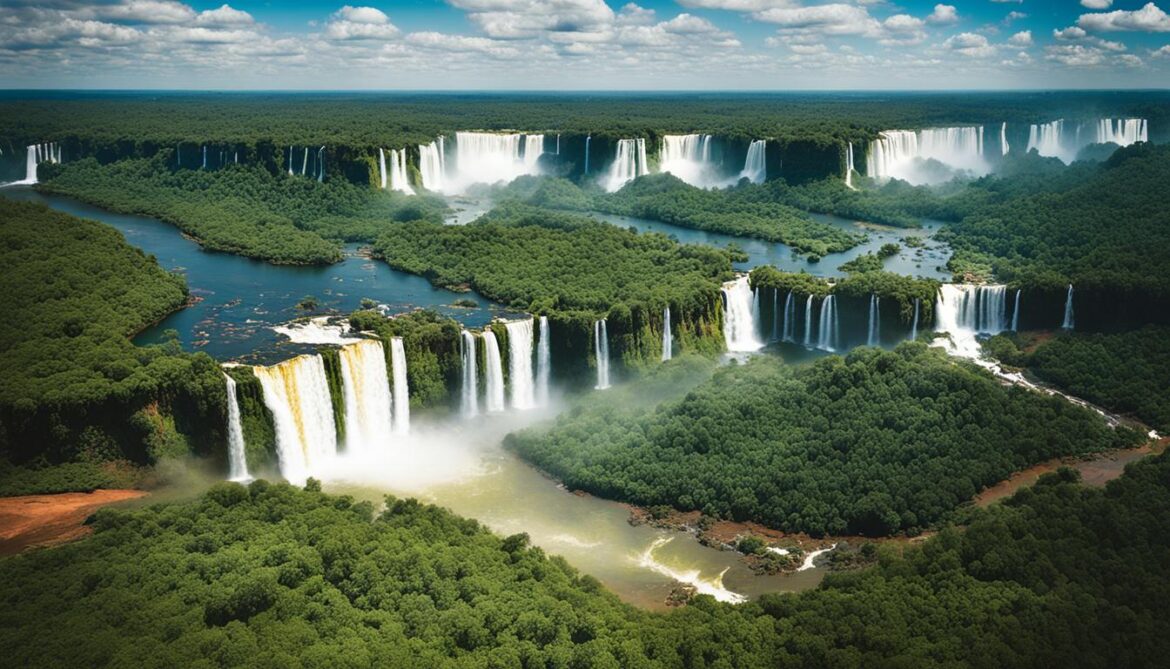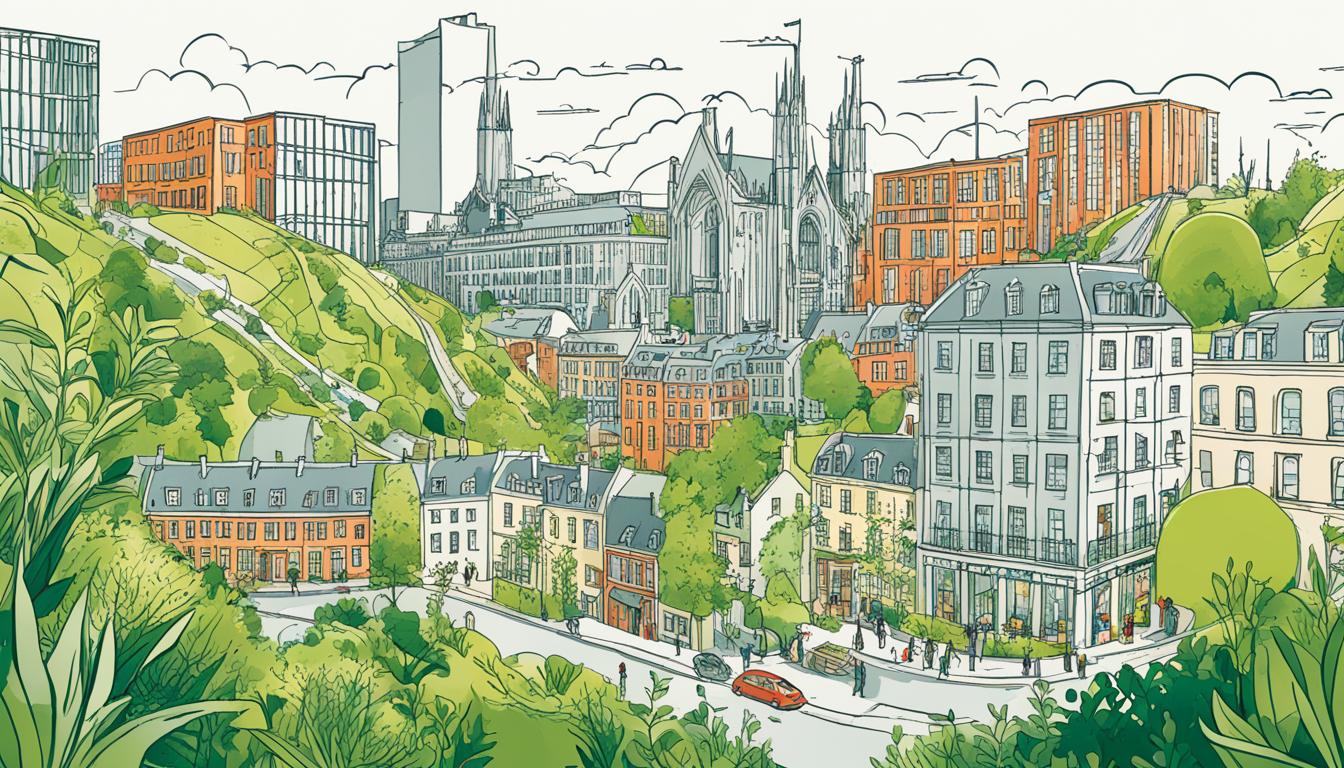Argentina Sacred Natural Sites and Biodiversity
Did you know that Argentina is home to a staggering number of sacred natural sites that contribute significantly to the conservation of its rich biodiversity? These sites, encompassing diverse ecosystems, hold immense cultural and spiritual significance for indigenous communities, making them more than just conservation areas. With sustainable management practices and a deep connection to traditional knowledge, Argentina’s sacred natural sites are safeguarding the nation’s natural heritage for future generations.
Key Takeaways:
- Argentina is home to numerous sacred natural sites that play a crucial role in conserving the nation’s biodiversity.
- Indigenous communities in Argentina are actively involved in forest conservation efforts and serve as guardians of the natural environment.
- The Gran Chaco, located in northern Argentina, is the second-largest forested ecoregion in the Americas and harbors immense biodiversity.
- Iguazu National Park, with its stunning waterfalls and subtropical rainforest, is recognized as one of the most biologically diverse natural sites in the world.
- Responsible tourism plays a crucial role in raising awareness about the importance of biodiversity conservation and supporting local communities.
Indigenous Communities’ Efforts in Forest Conservation
Indigenous communities in northern Argentina, such as the Guaraní and Wichí, play a vital role as the Guardians of the Mountain. These communities rely on the forests for their livelihoods and hold a deep connection to the land. Through their efforts, they actively protect sacred natural sites from poaching and deforestation, ensuring the preservation of Argentina’s rich biodiversity.
The Partner Forest Program Argentina works in collaboration with these indigenous communities, providing support and opportunities for cooperation. The program empowers these communities to manage their resources in a sustainable manner, maintaining the integrity of native forests and preserving the biological diversity they house.
This partnership aims to ensure the long-term sustainable management of forest products, while also safeguarding the cultural and spiritual significance of these sacred areas. By combining traditional knowledge and modern conservation practices, indigenous communities in Argentina are leading the way in protecting the natural heritage of the region.
Empowering Indigenous Communities
The Partner Forest Program Argentina recognizes the importance of indigenous communities in maintaining the balance between conservation and sustainable resource use. Through this collaboration, these communities gain greater control and autonomy over their ancestral lands, allowing them to continue their traditional practices and preserve their cultural heritage.
Empowering indigenous communities not only benefits these communities themselves but also contributes to the wider goal of biodiversity conservation. By involving local stakeholders in the decision-making process, the program ensures that management strategies are guided by their deep connection to the land and the knowledge passed down through generations.
This collaboration emphasizes the importance of traditional knowledge in natural resource management. Indigenous communities possess a wealth of knowledge about plant and animal species, habitat dynamics, and sustainable practices that have been developed and refined over centuries. By valuing and incorporating this traditional knowledge into conservation efforts, Argentina can effectively preserve sacred natural sites and protect its unique biodiversity.
“Indigenous communities in Argentina are not only the Guardians of the Mountain; they are the guardians of our natural heritage and cultural identity.” – Alberto Fernández, President of Argentina
| Benefits of Indigenous-Led Forest Conservation | Challenges of Indigenous-Led Forest Conservation |
|---|---|
|
|
Inspired by their deep connection to the land, indigenous communities in Argentina continue to demonstrate their commitment to preserving sacred natural sites and protecting biodiversity. Through their efforts and the support of programs like the Partner Forest Program Argentina, these communities are paving the way towards a more sustainable future that embraces both cultural heritage and environmental conservation.
Importance of Indigenous Knowledge and Cultural Connections
The indigenous communities in Argentina possess a profound spiritual and cultural connection with nature. They perceive themselves as dialogue-oriented, respecting others, and committed to living in harmony with the natural world. This deep-rooted connection enables them to understand and conserve the biodiversity of sacred natural sites.
Indigenous knowledge plays a vital role in the preservation of Argentina’s unique ecosystems. Passed down through generations, their traditional practices, rituals, and folklore are intricately interwoven with the natural environment. Consequently, these sacred sites not only serve as conservation areas but also as repositories of cultural heritage.
“We have inherited the wisdom of our ancestors and learned to respect and protect nature. Our traditions and rituals guide us in living sustainably and nurturing the abundance of life that surrounds us.” – Indigenous Community Leader
The Cultural Significance of Sacred Natural Sites
For indigenous communities in Argentina, sacred natural sites are not just physical locations, but they also hold deep cultural significance. These sites are of great importance for ceremonies, traditional knowledge sharing, and the preservation of spiritual and communal practices.
Indigenous rituals, such as offerings and ceremonies, are performed in these sacred places to establish a connection between people and nature. The belief in the interconnectedness of all living beings is at the core of their cultural practices, reinforcing the reverence and respect they have for the natural world.
Preserving Cultural Heritage and Biodiversity
Protecting the cultural heritage associated with sacred natural sites goes hand in hand with biodiversity conservation. Indigenous communities recognize that the preservation of their cultural practices, traditional knowledge, and rituals directly contributes to the safeguarding of these vital ecosystems.
By maintaining their cultural connections to the land, indigenous communities become stewards of biodiversity. Their holistic understanding of the interconnectedness and interdependence of species guides their sustainable management practices. They actively participate in the protection of endemic species and fragile ecosystems, ensuring the long-term survival of both their cultural heritage and the unique biodiversity found within sacred natural sites.

Empowering Indigenous Communities
Recognizing the cultural importance of biodiversity and the indigenous sacred areas, collaborative efforts are underway to empower indigenous communities in Argentina. These initiatives aim to provide support, resources, and recognition for their custodial role in safeguarding these sacred natural sites.
By fostering partnerships between indigenous communities, local organizations, and governmental bodies, sustainable management plans are developed. These plans leverage traditional knowledge and practices, integrating them with modern scientific research and conservation strategies.
This collaboration not only ensures the continued preservation of Argentina’s biodiversity but also supports the socio-economic development of indigenous communities by promoting sustainable tourism and the revitalization of traditional crafts and practices.
The Gran Chaco: A Biodiversity Hotspot
The Gran Chaco, located in northern Argentina, is an extraordinary region renowned for its remarkable natural heritage. As the second-largest forested ecoregion in the Americas, it holds immense cultural and ecological importance. The Gran Chaco is not only a sanctuary for unique flora and fauna but also home to indigenous communities and their sacred natural sites, embodying the delicate relationship between cultural diversity and biodiverse landscapes.

The Gran Chaco displays an incredible richness when it comes to biodiversity. Its tropical and subtropical dry forests provide habitats for a wide range of species, including many endemic ones. This unique ecosystem shelters magnificent creatures such as the tapirs, giant anteaters, howler monkeys, jaguars, and numerous other remarkable animals.
“The Gran Chaco is a testament to the interconnectedness of cultural importance and conservation biodiversity sacred sites. It represents a living heritage passed down from generation to generation, sustained by the indigenous sacred areas’ natural diversity.” – Indigenous Elder
Despite its ecological significance, the Gran Chaco faces significant challenges due to deforestation. Rapid agricultural expansion and unsustainable land-use practices threaten the integrity of this exceptional region. However, the cultural significance and traditional knowledge embedded within the indigenous sacred areas fuel the drive for conservation and sustainable management.
Efforts are underway to protect and restore the Gran Chaco, involving collaborations between indigenous communities, conservation organizations, and governmental entities. Through sustainable land-use practices and the recognition of the cultural importance of biodiversity in Argentina, there is hope for preserving this precious natural heritage for future generations.
Cultural Importance and Conservation Collaboration
The indigenous communities of the Gran Chaco have deep-rooted cultural connections to the natural world, recognizing the sacredness of the land and the vital role it plays in their lives. Their invaluable traditional knowledge and sustainable management practices contribute to the conservation of the region’s biodiversity, exemplifying the harmonious coexistence between humans and nature.
Through collaborative initiatives that celebrate the cultural importance of biodiversity in Argentina, indigenous communities, researchers, and conservationists join forces to develop effective strategies for safeguarding the Gran Chaco’s natural diversity. These collaborations prioritize indigenous leadership, traditional practices, and knowledge, ensuring a holistic approach to conservation.
The Gran Chaco stands as a testament to the delicate balance between cultural importance, conservation of biodiversity sacred sites, and sustainable land management. By recognizing and valuing the natural and cultural heritage, we can continue to preserve this remarkable region and its interconnected ecosystems.
Iguazu National Park: A Natural Wonder
Iguazu National Park, located on the border between Argentina and Brazil, is a natural wonder that captivates visitors with its awe-inspiring semicircular waterfalls. Cascading down from great heights, these massive falls, surrounded by a lush subtropical rainforest, create a breathtaking spectacle that showcases the raw power and beauty of nature.
The park is a sanctuary for biodiversity, boasting over 2,000 species of plants and a diverse range of wildlife. As you explore the park’s trails and viewpoints, you’ll encounter tapirs, giant anteaters, howler monkeys, ocelots, jaguars, and caymans, among many other fascinating creatures that call this ecosystem home. It’s a paradise for nature lovers and photographers, providing endless opportunities to witness rare and captivating wildlife in their natural habitat.

Iguazu National Park is not only visually stunning but also plays a crucial role in the conservation of Argentina’s sacred natural sites and biodiversity. The park serves as a vital corridor for the migration of species, ensuring their survival and genetic diversity. It is recognized as one of the most significant natural sites in the world, and its conservation efforts contribute to the global heritage of natural diversity.
Visiting Iguazu National Park is an opportunity to witness the power and magnificence of nature while supporting the preservation of Argentina’s natural heritage. Whether you’re marveling at the thunderous waterfalls or spotting wildlife amidst the dense rainforest, every moment spent in this natural wonderland is an invitation to appreciate and protect the delicate balance of our planet’s ecosystems.
Efforts in Protecting Iguazu National Park
Sustainable Management for Biodiversity Conservation
Iguazu National Park, a cherished part of Argentina’s National System of Federal Protected Areas, is dedicated to the conservation of biodiversity and the preservation of its sacred sites. Managed by trained professionals, including dedicated rangers, the park aims to strike a delicate balance between maintaining its natural heritage and providing visitors with a memorable experience.
The sustainability of Iguazu National Park is of utmost importance, given its significance in preserving the diverse ecosystems and spiritual connections to nature. To mitigate the impacts of tourism and safeguard the park’s incredible biodiversity, various measures are implemented. These include:
- The establishment of visitor limits and guided tours to minimize human disturbance
- Regular monitoring of the park’s ecosystems and wildlife populations
- Conservation education programs to raise awareness among visitors about the importance of protecting sacred sites and biodiversity
- The development of sustainable tourism practices to reduce the park’s ecological footprint
Through these comprehensive efforts, Iguazu National Park exemplifies the commitment towards sustainable management and the conservation of sacred sites to preserve Argentina’s natural heritage for future generations.
“In the heart of Iguazu National Park, we strive to protect the sacred sites and maintain the delicate balance between conservation and tourism. Together, we can ensure the sustainable management of these precious ecosystems.” – Park Ranger
Preservation and Restoration Initiatives
In addition to managing visitor activities, Iguazu National Park actively engages in preservation and restoration initiatives to enhance biodiversity conservation. These efforts include:
- Reforestation programs to restore and protect native plant species
- Research and conservation projects focusing on endangered wildlife species
- Collaboration with local communities and indigenous groups to promote sustainable land stewardship
- Implementation of sustainable waste management practices to minimize environmental impact
By conducting scientific research and partnering with communities, Iguazu National Park strives to protect and revitalize the biodiversity of its sacred sites. These conservation efforts preserve the essential cultural, ecological, and spiritual values associated with this remarkable natural wonder.

Collaboration for a Sustainable Future
The protection and sustainable management of Iguazu National Park’s sacred sites and biodiversity are not achievable through isolated efforts alone. Collaboration and partnerships play a vital role in achieving long-term conservation outcomes. Through collaborations with local communities, government agencies, and international organizations, the park can tap into diverse expertise and resources to ensure the sustainable future of these invaluable natural sites.
Together, these collaborative efforts work towards the common goal of preserving Argentina’s natural heritage, maintaining the cultural importance of biodiversity, and fostering sustainable management practices for the benefit of the planet and future generations.
The Importance of the Atlantic Forest in Biodiversity Conservation
The Atlantic Forest, of which Iguazu National Park is a part, is a global conservation priority under significant threat. This forest biome, once covering large parts of the Brazilian coast and extending into Argentina, Uruguay, and Paraguay, is renowned for its abundant species diversity and high levels of endemism. It provides crucial support to a wide range of flora and fauna, including the majestic Harpy Eagle, a rare and iconic species.
Conserving the Atlantic Forest is of utmost importance as it serves as a stronghold for biodiversity and plays a vital role in maintaining the delicate ecological balance. This unique ecosystem not only supports a plethora of plant and animal species but also holds immense cultural significance for the indigenous communities in the region.
The Atlantic Forest, with its natural heritage and cultural importance, is a treasure that must be safeguarded for the benefit of current and future generations.
Preserving the Atlantic Forest goes beyond protecting its rich biodiversity. It is also crucial for safeguarding the traditions, spiritual connections, and cultural heritage of the indigenous communities who consider these areas sacred. The Atlantic Forest is woven into their history, beliefs, and traditional practices, making it an integral part of their identity and way of life.
By conserving the Atlantic Forest, we not only preserve the natural wonders of Argentina but also honor and respect the indigenous sacred areas and their natural diversity. It is a testament to our commitment to sustainable practices and the lasting legacy we leave for future generations.
| Flora | Fauna |
|---|---|
| Over 20,000 plant species | Harpy Eagle |
| More than 2,000 tree species | Jaguar |
| Over 450 species of mammals | Giant Otter |
| More than 1,000 species of birds | Tapir |
| Over 350 species of amphibians | Howler Monkey |
| More than 400 species of reptiles | Ocelot |
The appreciation for the Atlantic Forest’s natural heritage, cultural importance, and indigenous sacred areas is a testament to our commitment to biodiversity conservation. Through collective efforts, we can ensure the preservation of this unique ecosystem for generations to come.
The Role of Partner Forests Program in Conservation
The Partner Forests Program plays a significant role in the conservation of sacred natural sites and biodiversity in Argentina. Through collaboration with indigenous communities, this program empowers them as stewards of the forests, ensuring the sustainable management of forest products and the preservation of traditional knowledge.
The partnership between the Partner Forests Program and indigenous communities enables economic resources to be provided, allowing them to protect their ancestral lands and safeguard the biological diversity of these sacred areas.
By valuing and supporting the traditional knowledge of indigenous communities, the Partner Forests Program recognizes the deep connection between cultural heritage and conservation. Through this collaboration, the program not only contributes to the preservation of sacred sites but also promotes sustainable practices that benefit both the environment and local communities.
The Sustainable Management of Sacred Sites and Biodiversity
The sustainable management of sacred sites and biodiversity is a crucial aspect of the Partner Forests Program. By integrating traditional knowledge and indigenous practices, the program ensures that the delicate balance between human activities and nature is maintained.
- Promoting traditional land management techniques that have been passed down through generations helps protect the diverse ecosystems found within these sacred areas.
- Educating and involving local communities in sustainable resource extraction enables them to meet their economic needs without compromising the long-term viability of the ecosystem.
- Implementing monitoring and conservation strategies allows for continuous assessment and adaptation to changing environmental conditions.
This holistic approach to conservation not only safeguards the unique biodiversity present in sacred natural sites but also fosters the cultural identity and well-being of indigenous communities.
Success Stories: Partner Forests Program in Action
The Partner Forests Program has achieved notable successes in promoting the sustainable management of sacred sites and biodiversity. One such success story is the collaboration between the program and the Mapuche community in the province of Neuquén.

| Success Story: Mapuche Community in Neuquén | Results |
|---|---|
| The Mapuche community actively participates in the conservation and restoration of sacred natural sites within their ancestral lands. | – Preservation of indigenous cultural practices. – Restoration of biodiversity in degraded areas. – Increased awareness and appreciation of sacred natural sites amongst the community and visitors. |
| The program provides financial support and technical assistance to the community, enabling them to implement sustainable land management practices. | – Economic empowerment of the community. – Enhanced capacity to protect and manage their ancestral lands. – Strengthened cultural resilience and self-determination. |
| The partnership promotes eco-tourism activities that respect the cultural and environmental sensitivities of the Mapuche community. | – Socioeconomic benefits for the community through responsible tourism. – Increased recognition and appreciation of the cultural and natural heritage of the Mapuche people. |
This success story exemplifies the positive outcomes that can be achieved through collaboration between the Partner Forests Program and indigenous communities. These partnerships not only contribute to the conservation of sacred natural sites and biodiversity but also foster socio-economic development and cultural preservation.
Restoring Sacred Carob Trees and Revitalizing Indigenous Practices
Deforestation has resulted in the loss of many sacred carob trees in indigenous communities, prompting restoration efforts to protect these invaluable ancient trees and their cultural significance. Sacred carob trees provide various benefits, including shade, medicinal leaves, wood for furniture and crafts, and food for animals.
The restoration of these trees is of utmost importance to indigenous communities who rely on them for their livelihoods and traditional practices. By reforesting sacred carob trees, indigenous communities are reclaiming their ancestral lands and preserving their cultural heritage for future generations.
Advocacy for the protection of indigenous lands and the restoration of sacred carob trees is facilitated through initiatives like the Nagoya Protocol. This international agreement promotes the fair and equitable sharing of benefits arising from the conservation and sustainable use of biological diversity.
Revitalizing indigenous practices and traditional knowledge is a key objective of the restoration efforts. By ensuring the sustainable use of biological diversity, indigenous communities can continue to practice their age-old customs and rituals that are intricately linked to these sacred carob trees.
Through collaborative efforts, including partnerships with environmental organizations and governmental support, indigenous communities are actively working towards the restoration and conservation of sacred carob trees. These efforts play a vital role in preserving biodiversity, protecting traditional knowledge, and fostering sustainable management of sacred sites.
Examples of Benefits Provided by Sacred Carob Trees
The ancient sacred carob trees offer numerous benefits to local communities:
- Shade: The dense foliage of carob trees provides shade, offering relief from the heat during hot summer months.
- Medicinal Leaves: The leaves of the carob tree have traditional medicinal uses, providing natural remedies for various ailments.
- Wood for Furniture and Crafts: The durable wood of carob trees is used in the creation of furniture, crafts, and decorative items.
- Food for Animals: The nutritious fruit pods of carob trees serve as a food source for animals, supporting local wildlife populations.
Progress of Sacred Carob Tree Restoration Efforts
| Indigenous Community | Number of Carob Trees Restored | Collaboration Partners |
|---|---|---|
| Community A | 250 | Local Environmental NGO |
| Community B | 150 | National Forestry Department |
| Community C | 300 | International Conservation Organization |

“The restoration of sacred carob trees is not only about reclaiming our ancestral lands and preserving our cultural heritage; it is also a means to ensure sustainable management and conservation of our sacred sites for the benefit of future generations.” – Indigenous Community Leader
Tourism and Awareness at Sacred Natural Sites
Sacred natural sites in Argentina, such as Iguazu National Park, attract a significant number of tourists each year. The mesmerizing beauty of these sites and their rich cultural heritage make them popular destinations for travelers from around the world. But beyond the aesthetic appeal, tourism also plays a crucial role in raising awareness about the conservation of biodiversity and the cultural significance of these sacred sites.
Visitors to these natural wonders have the opportunity to witness firsthand the incredible diversity of flora and fauna that thrives within these sacred areas. The lush forests, sparkling waterfalls, and unique ecosystems provide a captivating experience, allowing tourists to develop a deep appreciation for the natural world and the need to protect it.
Responsible tourism practices are widely promoted at sacred natural sites to minimize environmental impacts and support the local communities. Sustainable tourism initiatives ensure that visitors can explore these sites while leaving minimal ecological footprints. Local guides and experts educate tourists about the cultural importance of the biodiversity present in these areas, enhancing their understanding of the intricate relationship between humans and nature.
By immersing themselves in the beauty and significance of these sacred sites, tourists become advocates for their preservation. Their positive experiences and newfound knowledge inspire them to spread awareness among their peers, encouraging others to visit and support the conservation efforts in Argentina.
Furthermore, tourism revenue generated from these visits contributes to the sustainable development of the regions surrounding sacred natural sites. Local communities benefit from increased economic opportunities, leading to improved livelihoods and the empowerment of indigenous peoples who have been the stewards of these lands for generations.
Through responsible tourism practices and the promotion of awareness, Argentina can ensure the long-term conservation of its sacred natural sites, preserving its unique biodiversity and cultural heritage for future generations to cherish.
The Role of Tourism in Conservation
“Tourism can be a powerful vehicle for conservation, as it allows people to experience and connect with nature firsthand. By raising awareness and fostering a sense of stewardship, tourists become active participants in the conservation efforts of sacred natural sites.”
| Benefits of Tourism at Sacred Natural Sites | Role in Conservation |
|---|---|
| 1. Economic opportunities for local communities | 1. Generates revenue for conservation efforts |
| 2. Cultural exchange and preservation of indigenous traditions | 2. Raises awareness about the value of biodiversity |
| 3. Supporting environmental education and research | 3. Promotes responsible tourism practices |
| 4. Encouraging sustainable development | 4. Empowers local communities as stewards of the land |

By combining the preservation of natural heritage with cultural appreciation, responsible tourism at sacred natural sites in Argentina can contribute significant value to both the conservation of biodiversity and the local communities involved. It is through the collective efforts of visitors, indigenous communities, and conservation organizations that these unique sites can continue to thrive for generations to come.
Conclusion
Argentina’s sacred natural sites play a vital role in the conservation of the nation’s biodiversity, preserving its natural heritage for generations to come. These sites serve as a testament to the deep spiritual and cultural connections that indigenous communities have with nature. Through collaborative efforts with these communities, sustainable management practices are implemented to safeguard the unique ecosystems and traditional knowledge associated with these sites.
Preserving Argentina’s natural heritage is not only an imperative for biodiversity conservation but also a reflection of the enduring relationship between humans and the natural world. These sacred sites demonstrate the interconnectedness between nature, spirituality, and culture, providing valuable insights into the rich cultural importance of biodiversity in Argentina. It is through responsible tourism and awareness initiatives that visitors can witness the beauty of these sites and contribute to their preservation.
By continuing to support the sustainable management of sacred sites and acknowledging the traditional knowledge held by indigenous communities, Argentina can ensure the long-term conservation of its natural biodiversity. These sites are not only a source of inspiration and wonder but also serve as living testimony to the importance of sustainable practices and the protection of our world’s precious ecosystems.








